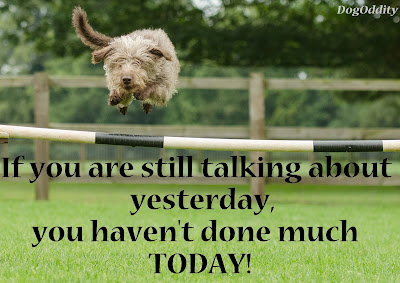Puppies learn about their environment by exploring and learning
which experiences were good or bad. Before a puppy is 12 weeks old they will
meet new situations with curiosity, after 12 weeks old they will approach with
apprehension.
Socialisation is about introducing them to all the animate
things they are likely to meet during their adult life, such as other dogs,
people of all varieties, sheep, cows, horses etc.
Giving your puppy lots of positive experiences when they
come across different situations will help them to be calm and happy throughout
their life and approach new things with confidence. With positive early
experiences they are much likely to bounce back if, at a later stage in life, they
meet something a little scary.
A puppy that is not introduced to a variety of experiences,
or that has a negative situation, will possibly express behaviour problems in
the future such as fear, anxiety and aggression. Therefore it’s vital to
socialise your puppy correctly.
Gently does it
The world can be a scary place for a young puppy, plus they are
not fully protected from potentially life threatening germs until they have
completed their vaccination program. Therefore it is important to take care and
introduce your dog to situations safely and positively in a way that does not
overwhelm them.
If a puppy becomes frightened of something before 12 weeks
old, it may struggle to get over that fear in later life. For example if your
puppy is taken along a busy road and gets a fright that overwhelms it, it may
become frightened of traffic for life, which will have a negative impact on
walking and travelling with your dog.
Your puppy should not be allowed to meet unfamiliar or unknown
dogs or walk on the ground along the pavement or in a park before it has
completed its vaccination program. Therefore you should carry your dog out and
about in your arms to give them some key socialisation opportunities. A short
walk along a few quiet streets for their first trip out will give your puppy appreciation
of new smells, sights and sounds.
Gradual scale
Experiences should be built up gradually, starting with very
small, gentle encounters that the puppy can cope with and then gradually increasing
their exposure day by day.
Use praise, tasty treats and fun toys to reward your puppy with
each new experience.
Your puppy does not have to come into actual contact with
something in order for them to socialise, it happens as soon as your puppy can
hear, smell and see them.
Things to socialise your puppy with
- People – adults, children, babies, men, women, people
wearing hats, people wearing coats, men with beards, ladies with sunglasses,
etc
- Dogs – different breeds and ages
- Animals – horses, chickens, cows, sheep, squirrels, etc
- Locations – the park, the woodland, the beach, etc
Remember gradual, gentle, positive experiences!
Socialising your puppy with different dogs
Puppies need to learn how to behave around other dogs. They
should not engage in play with every dog they meet as some dogs, such as older
dogs may find this distressful, painful or simply annoying.
Socialising a puppy with another dog should start with them
getting to see, smell and hear other dogs passing by. You could sit with your
puppy on a bench at a quiet park and let them watch other dogs, or stand with
them on the pavement as another dog walks by.
You could invite a friend and their friendly, vaccinated dog
around to visit you or you could go to visit your friends. Allow your puppy to
explore and greet in their own time, and if the puppy is trying to get away
from the adult dog then calmly and positively separate the dogs and keep the
adult dog from overwhelming the puppy, as well as interrupting the puppy if it becomes
too rough or persistent with the adult dog. Interactions should be kept very
short so as not to tire either dog out or allow your puppy to get too over
excited.
It will benefit your relationship with your dog if your puppy
is polite with other dogs and does not seek them out as a main source of fun,
you should be the most fun thing in a puppies life.
Recognise when your puppy is scared
Familiarise yourself with dog body language and pay
attention when your puppy looks scared. Common signs are the ears going back,
the tail drooping and being tucked underneath, wide staring eyes, lip licking
and the puppy may try to lean away or escape. If your puppy looks frightened
then remove them from the situation.
It is misguided to think that the puppy should face their
fears. Studies have shown that dogs’ fears will likely increase, making that
experience worse and have a negative impact on their future experiences. Keep
calm and gently remove your puppy to a familiar safe place.
Next make a plan to greatly reduce the intensity of the
experience they just found frightening and on another day introduce your puppy
to the lower intensity experience again with lots of reward. This may just
involve showing your puppy the object from a further distance away, or muffling
the sound so that it is quieter.
Socialisation continues for life
Although the key window for socialisation is before a puppy
reaches 12 weeks old, this doesn’t mean it stops here. Make sure that you pair
potentially new or more intense experiences with a reward to make the situation
positive for your dog.
If you have acquired your dog once it is over 12 weeks old
be sure to follow the socialisation guidelines above, gently introducing the
dog to new animate objects and pairing these with something rewarding.
Speak to a Dig It Instructor for further advice.
Remember…
Correct socialisation saves lives.































